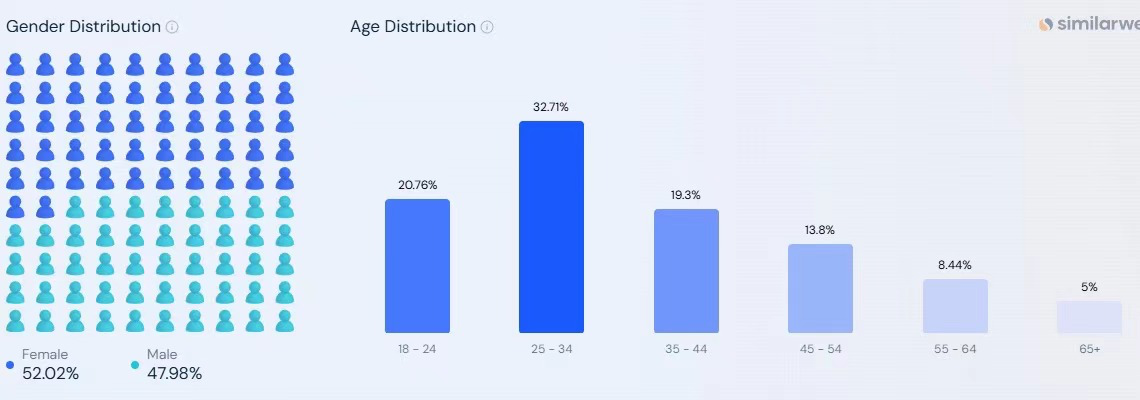1. Introduction
With the rapid development of technology, the mobile phone accessories industry has become an indispensable part of the lives of young consumers [1]. Personalized and sustainable products have become the core drivers of competition, with brands increasingly leveraging customized designs and eco-friendly concepts to enhance differentiation and market influence [2]. Casetify, a globally renowned brand, has achieved significant sales growth by utilizing social media platforms and collaborating with celebrities and influencers. However, while advancements in product functionality and personalization have been made, optimizing marketing strategies to meet the unique needs of different regional markets remains a challenge. In the Chinese market, for instance, the demand for high-end, customized accessories for local brands such as Xiaomi and Huawei has yet to be fully tapped, highlighting a critical gap in the current industry.
This study analyzes Casetify’s marketing strategy through its practices in market segmentation, target market selection, brand positioning, and the 4P marketing mix. By examining its performance in different regions, particularly in the Chinese market, the study identifies challenges and opportunities for growth. Drawing on public data, market reports, and social media insights, the article explores Casetify’s implementation of regional marketing strategies and proposes optimization suggestions for the Chinese market and global expansion. These include expanding product lines, strengthening regional customized marketing, and enhancing online and offline promotional channels. The findings aim to provide actionable strategies for Casetify's further expansion in China while offering reference suggestions for other brands on how to optimize marketing in diversified markets.
2. Background Information of Casetify and Analysis of the Chinese Market
As a Hong Kong brand founded in 2011, Casetify quickly gained market share among young consumers through its personalized, customized, and highly protective positioning and successfully operated in the United States, Chinese Mainland, South Korea, Australia, and other places. The brand quickly accumulated brand awareness and loyalty among young people through social media promotion and cooperation with celebrities and internet celebrities [3]. This diversified marketing strategy has helped the brand rapidly expand globally while also giving Casetify a unique high-end market positioning.
The mobile phone accessories market has grown rapidly globally in recent years. Nandasena pointed out that personalization and customization have become the core competitiveness of the electronic accessories industry, especially among young consumers [4]. The younger generation tends to choose products that reflect their personal style, not only in terms of brand preferences but also in terms of product materials and design. Taking the Chinese market as an example, although Casetify has successfully entered the Chinese market and occupied a certain market share in mobile phone accessories. However, there is also a significant gap in Casetify's phone case market, especially in the Chinese market, where the supply of phone case accessories for Xiaomi and Huawei phones is still insufficient.
3. Analysis of Casetify's Marketing Strategy
3.1. STP Model Analysis
The STP concept includes market segmentation, target market selection, and positioning. This concept emerged because marketers cannot meet the needs of all consumers. Its core lies in dividing the market into different segmented markets and developing corresponding positioning strategies for each segmented market [5]. So Casetify conducted in-depth analysis using the STP model, including market segmentation, target markets, and brand positioning. Firstly, as shown in Figure 1, Casetify accurately targeted the young consumer group aged 18 to 35 in terms of market segmentation, accounting for 20.76% and 32.71%, respectively. This group has the characteristics of pursuing personalization and highly valuing self-expression. Casetify further targets this segment among fashion trendsetters and internet celebrity fans, promoting the brand through collaborations with K-pop stars, fashion bloggers, and influencers on Instagram.
In terms of target market, Casetify has adopted a highly focused strategy, mainly targeting young people who follow the latest fashion and technology trends. The brand attracts a demand for both fashion and functionality through high-quality, customized phone cases and protective products. Personality, environmental friendliness, and luxury can also be applied to the Casetify phone case at the same time. Coupled with the influence of social media, it can successfully capture the preferences of young people and become an important brand choice for their personalization and pursuit of the market.

Figure 1: Casetify Domain Analysis for October 2024 [6]
3.2. 4P Marketing Mix
Profit is one of the key indicators for measuring marketing success, which can reflect a company's efforts to meet the desires and needs of its partners and help achieve business goals. This can not only help the company continue to grow and develop, but also provide higher levels of satisfaction for partners, thereby consolidating long-term cooperative relationships. At the same time, the success of marketing cannot be separated from key tools, including products, prices, place, and promotions [7]. These factors work together to drive Casetify's competitiveness in the market and play a key role in marketing mix strategies:
Product refers to any physical goods or services that consumers are willing to purchase, including tangible goods such as furniture, clothing, and food, and intangible products such as services. As the core element of the marketing mix, products are the foundation that influences consumer decisions and formulates marketing strategies [8]. When applied to Casetify, the diversified product portfolio provided by Casetify includes customizable phone cases, environmentally friendly material protective cases, etc., to meet the needs of different consumers. These products ensure a high level of protection while providing opportunities for self-expression through personalized design.
As one of the key elements of the marketing mix, price can have an overall impact on a company's revenue and market share. The price positioning of Casetify's products reflects its use of high-quality materials and customized design options. Its price usually ranges from 200 yuan to 400 yuan RMB.
Place refers to the technology and methods of providing products or services to customers through location or distribution [9]. Casetify mainly adopts online sales, especially through official websites and social media platforms such as Instagram, Facebook, etc. for promotion. Offline stores have physical stores and pop-up stores in major cities such as Los Angeles and Hong Kong, providing offline experience services.
The role of promotional strategies is to help businesses convey product information and services to customers in an informative manner [10]. In addition, in the industry, healthy buyers and sellers play an important leverage role through online promotions. So the guarantee factor for promotion is financial support, which is considered one of the most important resources in promotional activities [11]. Therefore, Casetify utilizes social media and influencer marketing to enhance brand influence. In terms of social media usage, it promotes through platforms such as Instagram and TikTok and combines user-generated content to enhance brand authenticity and market recognition.
4. Suggestions for Improving Marketing Strategies
In order to better adapt to the demands of the Chinese market and further increase its global market share, Casetify can consider the following three strategies for strategic improvement:
Firstly, to expand its product line and further capture market share in China, Casetify should prioritize launching high-end customized products suitable for Xiaomi and Huawei smartphones. These two major domestic mobile phone brands have a market share of 22.55% and 17.90%, respectively, in the Chinese market, ranking first and second in the Chinese market, accounting for a total of 40%, and are particularly sought after by young people [12]. Xiaomi and Huawei users not only have high requirements for functionality but also have significantly increased demands for fashion sense, personalization, and high protection of mobile accessories, especially for customized designs that can showcase their own style. Casetify can introduce design elements with regional characteristics or cultural symbols to cater to local user preferences, such as themed styles inspired by traditional Chinese culture or emerging trends. In addition, Casetify can meet users' needs for protection and sustainability by enhancing product durability and environmental performance, further enhancing the brand's appeal among these consumer groups. This product line expansion will not only help Casetify gain greater penetration in the Chinese market but also drive sales growth and enhance the brand's influence and competitiveness in the local market.
Secondly, there is a joint brand strategy. In order to better capture the attention of young consumers, Casetify can choose to collaborate with the popular local brand Pop Mart among millennial users. Pop Mart is loved by young people for its creative anime image and blind box model. Its proportion in China's toy market is the first shown in the Guanyan Report website in 2023, which complements Casetify's brand concept. As shown in Figure 2, Casetify can collaborate with Pop Mart to launch a customized series of products, incorporating Pop Mart's classic IP images (such as Molly and Labubu) into phone case design. Such co-branded products not only cater to young consumers who have a preference for anime and IP images but also can create a unique user experience and enhance brand recognition and differentiation. In addition, to further attract fans, Casetify can hold online lucky draws and limited-time discount activities during the joint series release period to enhance interaction and participation with users. This type of activity is easily spread widely on social media, which helps attract more potential consumers and enhance the brand's visibility and recognition in the Chinese market.


Figure 2: Created on the customized official website of Casetify
Finally, Casetify should make good use of the advantages of social media advertising. In terms of advertising placement, Casetify should fully utilize WeChat, a mainstream social platform in China with over 1.359 billion monthly active users, to improve advertising effectiveness through precise targeting. Casetify can place targeted advertisements on WeChat Moments based on users' age, consumption habits, and interests. By using celebrity endorsements or recommendations from amateurs (such as students, office workers, and fans who have washed Casetify), Casetify can more directly reach its target users and further increase the brand's authority and influence. At the same time, Casetify can also utilize the "interactive promotion" function of WeChat advertising to embed brand official websites and limited time promotional links into advertisements, encouraging users to click and participate, further enhancing user engagement and advertising conversion rates. In addition, Casetify can be promoted synchronously on platforms where young people gather, such as Xiaohongshu and Bilibili, to achieve multi platform linkage and increase brand exposure. This integrated advertising strategy will help Casetify establish a solid brand image among young Chinese consumers and lay the foundation for the brand's long-term development in the local market.
5. Conclusion
Overall, this article provides a systematic analysis of Casetify's global marketing strategy, exploring the practices and challenges in its STP model and 4P marketing mix. Casetify has gained widespread attention among young consumers through personalized product design and powerful social media promotion. However, in the Chinese market, Casetify still has shortcomings in meeting the demands of local mobile phone users such as Xiaomi and Huawei, which limits its development capabilities in the Chinese market. To this end, this article proposes three optimization suggestions, including expanding the product line that is compatible with local brands, collaborating with trendy toy brand Pop Mart, and increasing advertising efforts on social media platforms such as WeChat to enhance brand influence. Although this article adopts theoretical frameworks such as the STP model and 4P marketing mix, it mainly relies on public data and lacks field research and consumer interviews, resulting in limited insights into the target market. So in the future, we can further explore consumers' preferences for customized and environmentally friendly products under different cultural backgrounds, evaluate the potential application of this technology in marketing, and conduct in-depth analysis of brands. These directions are helpful for Casetify to develop more regionally adaptable marketing strategies and provide important references for its sustained development in the Chinese market.
Acknowledgement
Sincerely thank Prof. Acar for his valuable guidance and support throughout the study.
References
[1]. Filieri, R., & Lin, Z. (2017). The role of aesthetic, cultural, utilitarian and branding factors in young Chinese consumers' repurchase intention of smartphone brands. Computers in Human Behavior, 67, 139-150.https://doi.org/10.1016/j.chb.2016.09.057
[2]. Todeschini, B. V., Cortimiglia, M. N., Callegaro-de-Menezes, D., & Ghezzi, A. (2017). Innovative and sustainable business models in the fashion industry: Entrepreneurial drivers, opportunities, and challenges. Business horizons, 60(6), 759-770.https://doi.org/10.1016/j.bushor.2017.07.003
[3]. Laanti, N. (2023). Parasocial relationships between businesses and customers as a way of marketing: differences between three companies that implement it. https://www.theseus.fi/bitstream/handle/10024/801661/Laanti_Noora.pdf?sequence=2
[4]. Nandasena, D. H. M. H. M., & Dissanayake, D. M. T. D. (2021). Factors affecting the online purchasing intention of mobile phone accessories of millennials in Kurunegala District. The Journal of ARSYM, 83.
[5]. Kotler, P. & Keller K. L. (2005), Marketing Management, 12th edition, Pearson Prentice Hall, 24.
[6]. Similarweb. (2024). casetify.com Website Analysis for November 2024. https://www.similarweb.com/zh/website/casetify.com/#overview
[7]. Firman, A., Putra, A. H. P. K., Mustapa, Z., Ilyas, G. B., &Karim, K. (2020). Re-conceptualization of Business Model for Marketing Nowadays: Theory and Implications. The Journal of Asian Finance, Economics and Business (JAFEB), 7(7), 279–291.
[8]. Singh, M. (2012). Marketing mix of 4P’s for competitive advantage. IOSR Journal of Business and Management, 3(6), 40-45.
[9]. Martin (2014) Marketing Mix: Place in Four in P’s. Retrieved July, 29th 2019, from https://www.cleverism.com/place-four-ps-marketing-mix/
[10]. Al Karim, R., & Habiba, W. (2020). Influence of 4P strategy on organisation’s performance: a case on Bangladesh RMG sector. International Journal of Entrepreneurial Research, 3(1), 8-12.
[11]. Kincade, Doris H.; Woodard, Ginger A.; Park, Haesun, ”, International Journal of Consumer Studies, Dec2002, 26 (4), 294-302.
[12]. Rao, Xiangyu. (2024). The mobile phone market will usher in new changes in 2024. Journalist Observation (28), 70-71.
Cite this article
Wu,K. (2025). Marketing Strategy Evaluation and Recommendations for Casetify: Personalized Phone Cases in the Chinese Market. Advances in Economics, Management and Political Sciences,166,107-112.
Data availability
The datasets used and/or analyzed during the current study will be available from the authors upon reasonable request.
Disclaimer/Publisher's Note
The statements, opinions and data contained in all publications are solely those of the individual author(s) and contributor(s) and not of EWA Publishing and/or the editor(s). EWA Publishing and/or the editor(s) disclaim responsibility for any injury to people or property resulting from any ideas, methods, instructions or products referred to in the content.
About volume
Volume title: Proceedings of the 4th International Conference on Business and Policy Studies
© 2024 by the author(s). Licensee EWA Publishing, Oxford, UK. This article is an open access article distributed under the terms and
conditions of the Creative Commons Attribution (CC BY) license. Authors who
publish this series agree to the following terms:
1. Authors retain copyright and grant the series right of first publication with the work simultaneously licensed under a Creative Commons
Attribution License that allows others to share the work with an acknowledgment of the work's authorship and initial publication in this
series.
2. Authors are able to enter into separate, additional contractual arrangements for the non-exclusive distribution of the series's published
version of the work (e.g., post it to an institutional repository or publish it in a book), with an acknowledgment of its initial
publication in this series.
3. Authors are permitted and encouraged to post their work online (e.g., in institutional repositories or on their website) prior to and
during the submission process, as it can lead to productive exchanges, as well as earlier and greater citation of published work (See
Open access policy for details).
References
[1]. Filieri, R., & Lin, Z. (2017). The role of aesthetic, cultural, utilitarian and branding factors in young Chinese consumers' repurchase intention of smartphone brands. Computers in Human Behavior, 67, 139-150.https://doi.org/10.1016/j.chb.2016.09.057
[2]. Todeschini, B. V., Cortimiglia, M. N., Callegaro-de-Menezes, D., & Ghezzi, A. (2017). Innovative and sustainable business models in the fashion industry: Entrepreneurial drivers, opportunities, and challenges. Business horizons, 60(6), 759-770.https://doi.org/10.1016/j.bushor.2017.07.003
[3]. Laanti, N. (2023). Parasocial relationships between businesses and customers as a way of marketing: differences between three companies that implement it. https://www.theseus.fi/bitstream/handle/10024/801661/Laanti_Noora.pdf?sequence=2
[4]. Nandasena, D. H. M. H. M., & Dissanayake, D. M. T. D. (2021). Factors affecting the online purchasing intention of mobile phone accessories of millennials in Kurunegala District. The Journal of ARSYM, 83.
[5]. Kotler, P. & Keller K. L. (2005), Marketing Management, 12th edition, Pearson Prentice Hall, 24.
[6]. Similarweb. (2024). casetify.com Website Analysis for November 2024. https://www.similarweb.com/zh/website/casetify.com/#overview
[7]. Firman, A., Putra, A. H. P. K., Mustapa, Z., Ilyas, G. B., &Karim, K. (2020). Re-conceptualization of Business Model for Marketing Nowadays: Theory and Implications. The Journal of Asian Finance, Economics and Business (JAFEB), 7(7), 279–291.
[8]. Singh, M. (2012). Marketing mix of 4P’s for competitive advantage. IOSR Journal of Business and Management, 3(6), 40-45.
[9]. Martin (2014) Marketing Mix: Place in Four in P’s. Retrieved July, 29th 2019, from https://www.cleverism.com/place-four-ps-marketing-mix/
[10]. Al Karim, R., & Habiba, W. (2020). Influence of 4P strategy on organisation’s performance: a case on Bangladesh RMG sector. International Journal of Entrepreneurial Research, 3(1), 8-12.
[11]. Kincade, Doris H.; Woodard, Ginger A.; Park, Haesun, ”, International Journal of Consumer Studies, Dec2002, 26 (4), 294-302.
[12]. Rao, Xiangyu. (2024). The mobile phone market will usher in new changes in 2024. Journalist Observation (28), 70-71.









